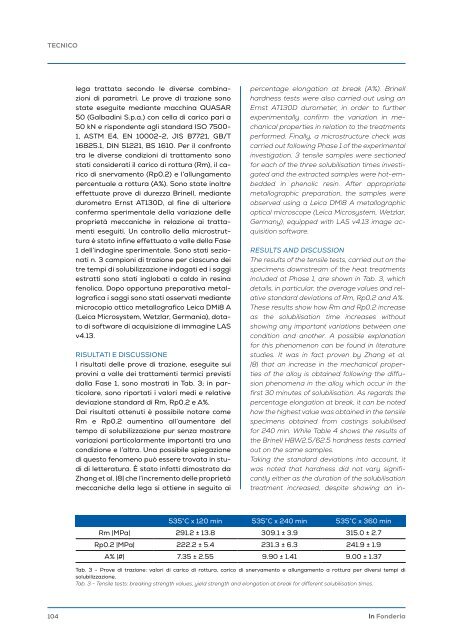In Fonderia 1 2024
Primo numero del 2024 di In Fonderia
Primo numero del 2024 di In Fonderia
Create successful ePaper yourself
Turn your PDF publications into a flip-book with our unique Google optimized e-Paper software.
TECNICO<br />
lega trattata secondo le diverse combinazioni<br />
di parametri. Le prove di trazione sono<br />
state eseguite mediante macchina QUASAR<br />
50 (Galbadini S.p.a.) con cella di carico pari a<br />
50 kN e rispondente agli standard ISO 7500-<br />
1, ASTM E4, EN 10002-2, JIS B7721, GB/T<br />
16825.1, DIN 51221, BS 1610. Per il confronto<br />
tra le diverse condizioni di trattamento sono<br />
stati considerati il carico di rottura (Rm), il carico<br />
di snervamento (Rp0.2) e l’allungamento<br />
percentuale a rottura (A%). Sono state inoltre<br />
effettuate prove di durezza Brinell, mediante<br />
durometro Ernst AT130D, al fine di ulteriore<br />
conferma sperimentale della variazione delle<br />
proprietà meccaniche in relazione ai trattamenti<br />
eseguiti. Un controllo della microstruttura<br />
è stato infine effettuato a valle della Fase<br />
1 dell’indagine sperimentale. Sono stati sezionati<br />
n. 3 campioni di trazione per ciascuna dei<br />
tre tempi di solubilizzazione indagati ed i saggi<br />
estratti sono stati inglobati a caldo in resina<br />
fenolica. Dopo opportuna preparativa metallografica<br />
i saggi sono stati osservati mediante<br />
microcopio ottico metallografico Leica DMi8 A<br />
(Leica Microsystem, Wetzlar, Germania), dotato<br />
di software di acquisizione di immagine LAS<br />
v4.13.<br />
RISULTATI E DISCUSSIONE<br />
I risultati delle prove di trazione, eseguite sui<br />
provini a valle dei trattamenti termici previsti<br />
dalla Fase 1, sono mostrati in Tab. 3; in particolare,<br />
sono riportati i valori medi e relative<br />
deviazione standard di Rm, Rp0.2 e A%.<br />
Dai risultati ottenuti è possibile notare come<br />
Rm e Rp0.2 aumentino all’aumentare del<br />
tempo di solubilizzazione pur senza mostrare<br />
variazioni particolarmente importanti tra una<br />
condizione e l’altra. Una possibile spiegazione<br />
di questo fenomeno può essere trovata in studi<br />
di letteratura. È stato infatti dimostrato da<br />
Zhang et al. |8| che l’incremento delle proprietà<br />
meccaniche della lega si ottiene in seguito ai<br />
percentage elongation at break (A%). Brinell<br />
hardness tests were also carried out using an<br />
Ernst AT130D durometer, in order to further<br />
experimentally confirm the variation in mechanical<br />
properties in relation to the treatments<br />
performed. Finally, a microstructure check was<br />
carried out following Phase 1 of the experimental<br />
investigation. 3 tensile samples were sectioned<br />
for each of the three solubilisation times investigated<br />
and the extracted samples were hot-embedded<br />
in phenolic resin. After appropriate<br />
metallographic preparation, the samples were<br />
observed using a Leica DMi8 A metallographic<br />
optical microscope (Leica Microsystem, Wetzlar,<br />
Germany), equipped with LAS v4.13 image acquisition<br />
software.<br />
RESULTS AND DISCUSSION<br />
The results of the tensile tests, carried out on the<br />
specimens downstream of the heat treatments<br />
included at Phase 1, are shown in Tab. 3, which<br />
details, in particular, the average values and relative<br />
standard deviations of Rm, Rp0.2 and A%.<br />
These results show how Rm and Rp0.2 increase<br />
as the solubilisation time increases without<br />
showing any important variations between one<br />
condition and another. A possible explanation<br />
for this phenomenon can be found in literature<br />
studies. It was in fact proven by Zhang et al.<br />
|8| that an increase in the mechanical properties<br />
of the alloy is obtained following the diffusion<br />
phenomena in the alloy which occur in the<br />
first 30 minutes of solubilisation. As regards the<br />
percentage elongation at break, it can be noted<br />
how the highest value was obtained in the tensile<br />
specimens obtained from castings solubilised<br />
for 240 min. While Table 4 shows the results of<br />
the Brinell HBW2.5/62.5 hardness tests carried<br />
out on the same samples.<br />
Taking the standard deviations into account, it<br />
was noted that hardness did not vary significantly<br />
either as the duration of the solubilisation<br />
treatment increased, despite showing an in-<br />
535°C x 120 min 535°C x 240 min 535°C x 360 min<br />
Rm |MPa| 291.2 ± 13.8 309.1 ± 3.9 315.0 ± 2.7<br />
Rp0.2 |MPa| 222.2 ± 5.4 231.3 ± 6.3 241.9 ± 1.9<br />
A% |#| 7.35 ± 2.55 9.90 ± 1.41 9.00 ± 1.37<br />
Tab. 3 - Prove di trazione: valori di carico di rottura, carico di snervamento e allungamento a rottura per diversi tempi di<br />
solubilizzazione.<br />
Tab. 3 - Tensile tests: breaking strength values, yield strength and elongation at break for different solubilisation times.<br />
104<br />
<strong>In</strong> <strong>Fonderia</strong>














